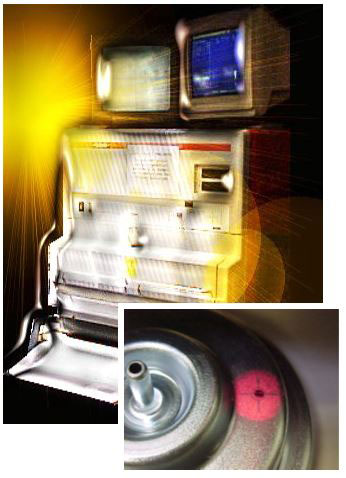TEL 860.283.0271 | FAX 860.283.8589 | EMAIL
Level of Standards
Measurement Devices
X-Ray Fluorescence
When a material is subjected to x-ray bombardment, some of its electrons will gain energy and leave the atom, creating a void in the vacated shell, thereby releasing a photon of x-ray energy known as x-ray fluorescence.
The energy level or wavelength of fluorescent x-rays is proportional to the atomic number of the atom and is characteristic for a particular material. The quantity of energy released will be dependent upon the thickness of the material being measured.
Basically, the x-ray fluorescence unit consists of an x-ray tube and a proportional counter. Emitted photons ionize the gas in the counter tube proportional to their energy, permitting spectrum analysis for determination of the material and thickness.
X-ray fluorescence is the most precise measurement method, especially for small-diameter parts, or dual coatings such as gold and nickel over copper.
Eddy Current
The eddy-current technique is a non-destructive method of determining coating thickness used for measuring both non-magnetic, metallic coatings over steel and non-conductive coatings over non-ferrous metals.
When a conductive material is subjected to an AC magnetic field from a probe, eddy-currents occur in the material in proportion to the frequency and resistivity. The induced eddy currents generate an opposing magnetic field which alters the circuit reactance and the output voltage of the probe. The change in output voltage is used to calculate the coating thickness. Electrical conductivity between the coating and substrate should differ by a ratio of 2:1 for optimum accuracy.
Non-conductive coatings introduce a gap (lift-off) between the probe and non-ferrous base material. This gap produces a loss in eddy current penetration which is compared to a measurement directly on the base material to determine coating thickness.
With conductive coatings over steel, eddy currents are generated in both the coating and ferrous base material. Eddy current loss in both materials is proportional to the coating and substrate material thickness and will range somewhere between readings taken directly on pure samples of each material. The eddy current loss differential is used to calculate coating thickness.
Gold Standard Process and Facilities Help Drive our Progressive Model and Problem-Solving Skill, Including:
- ISO 9001: 2015 certification
- Advanced processes for services such as vapor degreasing, alkaline and critical cleaning
- Military specification and ASTM specification for passivation
- Federal and military specification for oxides & phosphates
- Over 160,000 square feet of optimized production lines
- Dedicated quality control facilities and teams, with advanced testing technologies
- 1 year assurances on solvent- and water-based rust preventatives
- Strict tolerance consistency standards through computer-aided technology
- State-of-the-art waste treatment programs with full-time environmental staff
- Compliance with proper state and federal permitting requirements
- Compliance to RoHS, WEEE & ELV directives
- GMW 3044 certified
 TAKING STEPS TOGETHER
TAKING STEPS TOGETHERUniMetal’s George and Stacy LaCapra have helped the United Way of Greater Waterbury raise $3.75 million.
Read More >